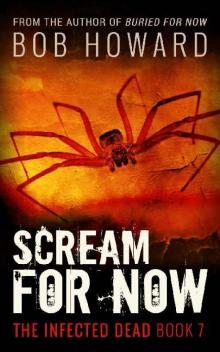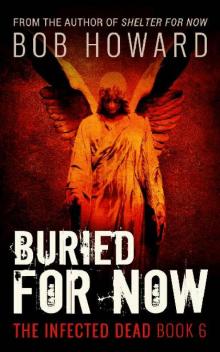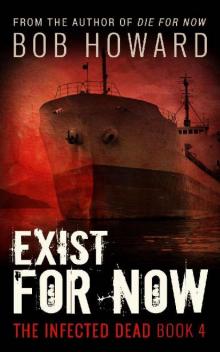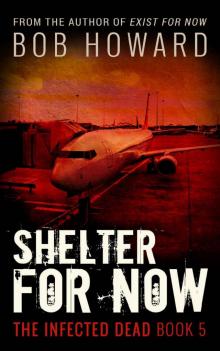- Home
- Howard, Bob
The Infected Dead (Book 5): Shelter for Now Page 5
The Infected Dead (Book 5): Shelter for Now Read online
Page 5
The President told the head of his security detail to go find out what was happening. After his outburst toward the flight crew on the previous evening it was better for everyone if he stayed off of the flight deck..
The Secret Service agent wasn’t gone more than a couple of minutes. He knew the President would expect an answer quickly.
“Mr. President, there’s an Army vehicle in front of us, and we’re following him toward the hangars on the other side of the long runway.”
“It’s about time,” he answered.
The agents who stood ready to keep the President from harm exchanged silent eye contact. During the night they had quietly agreed that they hoped the Army didn’t show up at night when it would be harder to see. They were badly outnumbered, and although their primary mission was to ensure the safety of the President, they wouldn't mind if it meant they would be saved too.
As Air Force One followed the Stryker, Executive One turned onto the same taxiway and fell in behind the 747. The President could see the runway from the port side windows.
“What’s that imbecile doing?”
“That’s Executive One, Sir. That’s the 737 that flew you out of DC last night.”
“Does he think that gives him the right to follow me? There’s a big crowd of those monsters following him. He’s going to bring them right to us.”
The First Lady had come in from the sleeping quarters and was listening to the exchange between her husband and the respectful agent. She put her hand on her husband’s arm and said in a low voice that she thought it was reasonable for the crew of the 737 to hope they could be saved, too.
President Freeman had won the world’s biggest popularity contest when he had been elected President, but the agents around him knew very well he wouldn’t win any popularity contests if the voters really knew him.
As if to accent the point, the President flew into another outburst of rage when the 737 behind them made its turn and opened up a better view of the planes that were lined up behind Executive One. The size of the infected horde had made air shows into a national event with so many of them gathering around the planes.
The morning was clear of clouds, so the sun illuminated the runway and gave them a good view. Six passenger flights had joined the procession and were all moving in a straight line for the taxiway. The infected weren’t just following the planes, they were going where living people were, and they were converging from all directions.
The Stryker continued to roll slowly in reverse toward the cluster of hangars at the end of the main runway, seemingly unconcerned about the other flights or the infected. They reached the end of the taxiway, made a slight turn to the right, and then resumed their original course toward the same hangar where the Stryker had first appeared.
It didn’t take long for them to cross the wide runway, and eventually the Stryker backed into the dark opening of the hangar door. The pilot kept his eyes on the man sitting in the hatch who continued to move his arms in a motion that meant to keep coming forward. When the man held up a hand for him to stop and then crossed his arms above his head, the pilot pressed on the brake pedal and began to power down.
Air Force One was sitting with the forward half of the plane inside, and everything from the wings back was outside in the bright sunshine. The other planes came to a stop and waited for some sign of what to do. The passengers and crews couldn’t see too far into the darkness of the hangar, but each flight crew assumed they were part of a massive effort to save the hundreds of lives that were trapped inside the planes. The flight crews had started talking over the radio, but none of them had heard from Air Force One.
The Stryker moved a little closer to the front of Air Force One, and the man in the helmet gave the signal to use the radio again.
The co-pilot listened without speaking and then put the headset aside.
“He said to get everyone ready to disembark.”
“I don’t suppose he gave you a clue how we’re going to get off the plane,” said the pilot.
The co-pilot just shook his head. All they could do was leave it in the hands of the Army.
Word was given to the Secret Service to begin preparations to disembark, so they made sure everyone was ready. Weapons were prepared, and the family was surrounded by their security details. As a precaution against bites, the agents had bundled the family in extra layers of clothing.
Without any further instructions, the agents didn’t know what else to do, so they had everyone gather down the aisles leading to the main cabin door. The President and his family were the closest to the door, and the other aisle was reserved for the staffers and the few lucky reporters who had managed to make it to the plane. Normally, there would have been many more people along for the ride, but the sudden switch to Executive One at Andrews Air Force Base had caused some to be left behind in the confusion. He didn’t know, nor did he really care that everyone had gotten off of Executive One, but many had been left standing on the tarmac. When Air Force One closed its doors and pulled away, they found Executive One had already done the same.
Both aisles sat and waited. Along the body of the plane outside, hundreds of hands reached upward. The pilots sat and stared into the darkness of the hangar wondering where the Stryker had gone. They had been so busy they hadn’t noticed when it had backed away from the plane.
They heard something happening before they saw what it was, and the cabin crew rushed to the side windows and stared into the darkness for a clue. It was the deep, scraping noise of metal moving against metal.
“Over there,” said the pilot.
He pointed out the left side window and then moved over so his co-pilot and navigator could join him. He was drawing their attention toward a spot that was roughly in line with the main cabin door where the floor was moving so much to trip the infected. As dark as it was, some of the infected seemed as if they had found a way to climb up the side of the plane, but the crew saw it was an illusion. They were rising upward, but not under their own power. The floor was rising underneath them.
A square platform approximately twelve feet long on each side was ascending next to the plane. The infected dead that were standing on top of it were losing their balance and falling back to the concrete floor below. It continued to rise until it was even with the top of the main cabin door, and when it lurched to a stop, three more of the infected went over the side.
From the windows where the pilots were watching and from the windows in the front passenger section, they could still see four of the infected standing on the platform. They were staggering and still trying to get their feet under them in order to walk, but one by one they managed to get their balance.
The pilot rapped on his window, and all four turned in his direction. Their reaction to seeing a living person only a few feet away was immediate, and they walked toward him.
The Secret Service agents saw the remaining infected go over the other side of the huge platform, so the agent in charge had the flight crew open the main cabin door a few inches. He was surprised to be facing another door only inches away.
There was a slight gap between the two doors, and the agent understood it hadn’t just been a platform. It was an enclosed elevator. He reached across and pulled aside a large lever, and the door opened. The compartment inside was well lit, and a pair of US Army soldiers in battle dress uniforms snapped to attention.
“Sir, if you could please have the President and his party enter the lift, we should get going,” said one of the soldiers in a crisp military voice.
The agent was dumbfounded but not so much that he didn’t understand what was happening. This had all been planned in advance. All they had to do was get the President to the airport in Columbus, and someone else would take care of the rest.
One of the soldiers boarded Air Force One and gave a quick explanation to the agents. He said the capacity of the lift was twenty, so they would go down in shifts.
While they were in the process of boarding, he
told them that down below was a deep shaft. The lift would only descend until the platform roof was level with the floor, then they would disembark into a tunnel where a vehicle would be arriving for them.
“I have a question,” said the agent in charge. “While the lift is in the air, isn’t the shaft exposed, and aren’t those infected things falling into the open shaft?”
“Yes, Sir, but the shaft is actually close to two hundred feet deep, so whatever falls in while we’re up here is going to be well below where we stop.”
The agent thought it over for a few seconds and then asked, “How long will it take to fill a two hundred foot hole with bodies if you have about a thousand bodies walking into that hole?”
“Don’t worry, Sir. It’s my understanding that someone already thought of that. By the time we get everyone down, there will still be plenty of room in that hole.”
“Someone already thought of that,” the agent said more to himself than to the soldier. “I want to meet the guy who thought of that….or maybe I don’t.”
Once the lift was full, it was closed shut and began to lower. The lights inside were kept on, and it was much like riding down a few floors in a slow elevator. When it bumped to a stop, there was a knock on the other side of the door before it began to open.
The occupants of the lift stepped out onto a passenger loading platform that would have been normal in any underground railroad station. There were comfortable benches along the walls on a raised area above a set of tracks, and the tracks disappeared down a brightly lit tunnel.
One of the agents walked to the edge and leaned out to peer down the tunnel. He wasn’t sure what he would see, but the tunnel curved away in the distance. Just as he leaned backward he saw motion, and it was coming down the tracks at high speed.
The passenger train came to a smooth stop in front of the raised passenger boarding area. It was painted the same blue and white colors as Air Force One, and it had the Presidential Seal on the side of the first car.
For the first time since this strange event began, the President smiled with satisfaction. He had hardly believed that the president of the most powerful country in the world had been forced to run from his own home whether it was from a disease or an enemy attack. As far as he was concerned, the people guarding the White House were incompetent, and he planned to have everyone replaced when he got home.
He saw the flight crew standing away from the rest of his party and motioned for the pilot to come talk with him.
“Yes, Mr. President?”
“You knew about this all along, didn’t you.” It was more of a statement than a question.
The pilot was confused by the statement and how the President had come to that conclusion, so he didn’t have time to answer. It wasn’t exactly an apology for his earlier behavior toward the flight crew, but knowing President Freeman, it was the closest he would ever come to an apology.
President Freeman turned away from him without dismissing him, so the pilot was left standing there not knowing what to do. He was relieved when the doors of the train slid open because the President didn’t hesitate to hustle his family into the first car.
The agent on the train stopped a surprised aid from boarding and said the train was filled to capacity, leaving at least half of the people in the sitting area or standing on the platform. It seemed the capacity of the train had been somewhat overestimated. Either that, or the presidential party took up more space than they needed. The lift had gone up for a second time, and a steel gate had closed across the opening where the lift had been.
Less than a minute later the first of the infected dead flew downward past the entrance. The lift had gone above the floor of the hangar, and the open hole was catching its fair share of the infected that came too close to its edge. A few minutes later the bodies stopped falling as the lift once again filled the hole. The train hadn’t returned for a second load, so more people from the plane were squeezed into the passenger loading area.
“Maybe we should get them to wait before going up for the next group,” said the co-pilot.
“I was thinking the same thing,” said the pilot, “but what about Executive One and all of the people in the planes behind them? How are they supposed to get their planes into position for the lift to reach their doors?”
“We can’t just leave them up there.”
“I don’t think President Freeman is too worried about them,” said the pilot.
Before the pilot could make his way through the crowd that had unloaded from the lift, the gates closed again and the lift ascended upward.
The bodies fell past them for a second time but this time in even larger numbers. That could only mean the crowd of infected up above had become larger.
Just as the crew was starting to worry that the elevator shaft would become full, the rain of bodies stopped again. A minute later the door to the lift swung open, and more grateful people squeezed out into the passenger waiting area.
The pilot caught the soldier by the arm and asked, “What about the other planes up there? We can’t just leave those people up there to die.”
“I’m sorry, Sir. I don’t have any orders about them. That was the last trip up to Air Force One, Sir.”
The soldier disappeared into the crowd just as the train reappeared from the tunnel. There was some pushing and shoving as people tried to be in the next train to leave. It was still too crowded when the train pulled away. The little underground railroad station wasn’t intended for such a big crowd.
Just as the train left the platform, there was a scream, and that caused people to push harder. Someone fell off of the passenger platform, and an angry husband or boyfriend threw a punch at the offender who caused the fall.
In the melee that followed no one noticed that passengers inside the train were trying to pull the doors open from the inside, and there was a smear of blood on the window.
The pushing, shoving, and punching went on for several minutes until the soldier and several Secret Service agents managed to restore order. People were separated from each other, apologies were exchanged, and everything settled back down as they waited for the train to return.
******
Outside the hangar up above, the crew of Executive One tried again to raise the crew of Air Force One on the radio. There wasn’t enough light inside the hangar for them to see the lift that had extended from the floor all the way to the main cabin door of the big 747. They didn’t know they were sitting behind an empty plane, and that there was no plan for their rescue.
The Stryker they had seen leading the planes to the hangar emerged from the darkness and drove up to the nose of Executive One. The pilot put his headset on and was immediately greeted by a sergeant who gave him the bad news.
“What do you mean you can’t help us?” he yelled into the microphone.
Before he could even get an answer the Stryker had moved on to the next plane in line.
“What did he say?” asked the co-pilot.
“He said they were sorry and that they had only planned for the arrival of Air Force One. He said they would bring reinforcements, and we could use the opportunity to get away from the planes or take off.”
As the first Stryker went from plane to plane, five more of the military vehicles emerged from the hangar and began systematically clearing the crowd of infected dead from around the planes. They moved slowly and they stayed close to the planes, shooting outward. The vehicles themselves were used to dispose of the infected that were close to the planes, crushing them under the huge tires.
It became obvious after only a few minutes that they wouldn’t be able to clear the entire area. The Stryker vehicles were laying down a devastating barrage of fire that would have been enough against conventional ground forces, but the infected just kept coming. The crowd was far too numerous for them to clear.
The lead Stryker radioed Executive One and suggested that they should try to take off and fly to Rickenbacker International Airport. The serg
eant said there was a military reserve unit there that was run by the Navy and the Marine Corps, and they had received instructions to proceed there as soon as possible.
The sergeant wished them good luck, and to the horror of the passengers on the planes lined up behind Executive One, the Strykers began driving toward the southern exit of the airport.
In the passenger planes behind Executive One, the flight crews were having the same discussions with their passengers. Passengers were yelling threats, and some were demanding action. Some were even demanding to be allowed off of the planes. Where they hoped to go was anybody’s guess.
The first plane in line behind Executive One began to power up and make a slow turn toward the grassy area between the hangars and the end of the runway.
It was clear that the pilot intended to reach the runway and take off, but all of the flight crews watching from the other planes were holding their collective breath. The ground in the grassy areas was green and well tended, but the runways were slightly elevated to allow them to drain well when it rained.
Executive One didn’t have the weight of hundreds of passengers, so they could probably make it easily, but the heavier planes were going to be in trouble if the landing gear passed over a soggy patch.
The front end of the passenger jet reached the tarmac, and the front wheels were having difficulty making it over the lip of the runway, but the plane lurched forward and upward. The rear wheels reached the edge at an angle because the pilot began turning, and the big tires easily climbed onto the pavement.
There was cheering on each of the passenger planes as the first plane began rolling forward and gaining speed for take off. If not for the Strykers, there would have been far more infected walking on the runway, but they had thinned the crowd just enough. The remaining infected were also following the plane as it moved across the grass.
The next plane in line began to turn, and his dilemma was clear. He could either use the same path the first plane had taken and risk getting stuck in a rut created by the first plane, or he could try a new, untested path.

 The Infected Dead (Book 7): Scream For Now
The Infected Dead (Book 7): Scream For Now The Infected Dead (Book 6): Buried For Now
The Infected Dead (Book 6): Buried For Now The Infected Dead (Book 4): Exist For Now
The Infected Dead (Book 4): Exist For Now The Infected Dead (Book 2): Survive For Now
The Infected Dead (Book 2): Survive For Now The Infected Dead (Book 5): Shelter for Now
The Infected Dead (Book 5): Shelter for Now